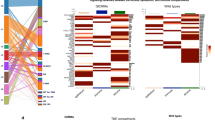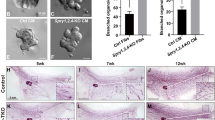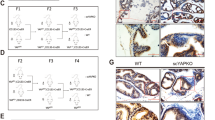Abstract
The Hedgehog (Hh) pathway contributes to prostate cancer growth and progression. The presence of robust Sonic Hedgehog (Shh) expression in both normal prostate and localized cancer challenged us to explain the unique growth-promoting effect in cancer. We show here that paracrine Hh signaling exerts a non-cell autonomous effect on xenograft tumor growth and that Hh pathway activation in myofibroblasts alone is sufficient to stimulate tumor growth. Nine genes regulated by Hh in the mesenchyme of the developing prostate were found to be regulated in the stroma of Hh overexpressing xenograft tumors. Correlation analysis of gene expression in matched specimens of benign and malignant human prostate tissue revealed a partial five-gene fingerprint of Hh-regulated expression in stroma of all cancers and the complete nine-gene fingerprint in the subset of tumors exhibiting a reactive stroma. No expression fingerprint was observed in benign tissues. We conclude that changes in the prostate stroma due to association with cancer result in an altered transcriptional response to Hh that mimics the growth-promoting actions of the fetal mesenchyme. Patients with an abundance of myofibroblasts in biopsy tissue may comprise a subgroup that will exhibit a particularly good response to anti-Hh therapy.
This is a preview of subscription content, access via your institution
Access options
Subscribe to this journal
Receive 50 print issues and online access
$259.00 per year
only $5.18 per issue
Buy this article
- Purchase on Springer Link
- Instant access to full article PDF
Prices may be subject to local taxes which are calculated during checkout






Similar content being viewed by others
References
Bai CB, Auerbach W, Lee JS, Stephen D, Joyner AL . (2002). Gli2, but not Gli1, is required for initial Shh signaling and ectopic activation of the Shh pathway. Development 129: 4753–4761.
Bhatia N, Thiyagarajan S, Elcheva I, Saleem M, Dlugosz A, Mukhtar H et al. (2006). Gli2 is targeted for ubiquitination and degradation by beta-TrCP ubiquitin ligase. J Biol Chem 281: 19320–19326.
Bierhoff E, Walljasper U, Hofmann D, Vogel J, Wernert N, Pfeifer U . (1997). Morphological analogies of fetal prostate stroma and stromal nodules in BPH. Prostate 31: 234–240.
Fan L, Pepicelli CV, Dibble CC, Catbagan W, Zarycki JL, Laciak R et al. (2004). Hedgehog signaling promotes prostate xenograft tumor growth. Endocrinology 145: 3961–3970.
Gustin MP, Paultre CZ, Randon J, Bricca G, Cerutti C . (2008). Functional meta-analysis of double connectivity in gene coexpression networks in mammals. Physiol Genomics 34: 34–41.
Hui CC, Joyner AL . (1993). A mouse model of greig cephalopolysyndactyly syndrome: the extra-toesJ mutation contains an intragenic deletion of the Gli3 gene. Nat Genet 3: 241–246.
Janik P, Briand P, Hartmann NR . (1975). The effect of estrone-progesterone treatment on cell proliferation kinetics of hormone-dependent GR mouse mammary tumors. Cancer Res 35: 3698–3704.
Karhadkar SS, Bova GS, Abdallah N, Dhara S, Gardner D, Maitra A et al. (2004). Hedgehog signalling in prostate regeneration, neoplasia and metastasis. Nature 431: 707–712.
Kelleher FC, Fennelly D, Rafferty M . (2006). Common critical pathways in embryogenesis and cancer. Acta Oncol 45: 375–388.
Lauth M, Bergstrom A, Shimokawa T, Toftgard R . (2007). Inhibition of GLI-mediated transcription and tumor cell growth by small-molecule antagonists. Proc Natl Acad Sci USA 104: 8455–8460.
Lauth M, Toftgard R . (2007a). Non-canonical activation of GLI transcription factors: implications for targeted anti-cancer therapy. Cell Cycle 6: 2458–2463.
Lauth M, Toftgard R . (2007b). The Hedgehog pathway as a drug target in cancer therapy. Curr Opin Investig Drugs 8: 457–461.
Levitt RJ, Zhao Y, Blouin MJ, Pollak M . (2007). The hedgehog pathway inhibitor cyclopamine increases levels of p27, and decreases both expression of IGF-II and activation of Akt in PC-3 prostate cancer cells. Cancer Lett 255: 300–306.
Lipinski RJ, Gipp JJ, Zhang J, Doles JD, Bushman W . (2006). Unique and complimentary activities of the Gli transcription factors in Hedgehog signaling. Exp Cell Res 312: 1925–1938.
Lum L, Beachy PA . (2004). The Hedgehog response network: sensors, switches, and routers. Science 304: 1755–1759.
McCarthy FR, Brown AJ . (2008). Autonomous Hedgehog signalling is undetectable in PC-3 prostate cancer cells. Biochem Biophys Res Commun 373: 109–112.
Rhodes DR, Kalyana-Sundaram S, Mahavisno V, Barrette TR, Ghosh D, Chinnaiyan AM . (2005). Mining for regulatory programs in the cancer transcriptome. Nat Genet 37: 579–583.
Rhodes DR, Kalyana-Sundaram S, Mahavisno V, Varambally R, Yu J, Briggs BB et al. (2007a). Oncomine 3.0: genes, pathways, and networks in a collection of 18 000 cancer gene expression profiles. Neoplasia 9: 166–180.
Rhodes DR, Kalyana-Sundaram S, Tomlins SA, Mahavisno V, Kasper N, Varambally R et al. (2007b). Molecular concepts analysis links tumors, pathways, mechanisms, and drugs. Neoplasia 9: 443–454.
Rhodes DR, Yu J, Shanker K, Deshpande N, Varambally R, Ghosh D et al. (2004). ONCOMINE: a cancer microarray database and integrated data-mining platform. Neoplasia 6: 1–6.
Roessler E, Ermilov AN, Grange DK, Wang A, Grachtchouk M, Dlugosz AA et al. (2005). A previously unidentified amino-terminal domain regulates transcriptional activity of wild-type and disease-associated human GLI2. Hum Mol Genet 14: 2181–2188.
Sanchez P, Hernandez AM, Stecca B, Kahler AJ, DeGueme AM, Barrett A et al. (2004). Inhibition of prostate cancer proliferation by interference with Sonic Hedgehog-Gli1 signaling. Proc Natl Acad Sci USA 101: 12561–12566.
Schimmang T, van der Hoeven F, Ruther U . (1993). Gli3 expression is affected in the morphogenetic mouse mutants add and Xt. Prog Clin Biol Res 383A: 153–161.
Schwarze SR, Luo J, Isaacs WB, Jarrard DF . (2005). Modulation of CXCL14 (BRAK) expression in prostate cancer. Prostate 64: 67–74.
Shaw A, Papadopoulos J, Johnson C, Bushman W . (2006). Isolation and characterization of an immortalized mouse urogenital sinus mesenchyme cell line. Prostate 66: 1347–1358.
Sheng T, Li C, Zhang X, Chi S, He N, Chen K et al. (2004). Activation of the hedgehog pathway in advanced prostate cancer. Mol Cancer 3: 29.
Stuart JM, Segal E, Koller D, Kim SK . (2003). A gene-coexpression network for global discovery of conserved genetic modules. Science 302: 249–255.
Tuxhorn JA, Ayala GE, Rowley DR . (2001). Reactive stroma in prostate cancer progression. J Urol 166: 2472–2483.
Tuxhorn JA, Ayala GE, Smith MJ, Smith VC, Dang TD, Rowley DR . (2002). Reactive stroma in human prostate cancer: induction of myofibroblast phenotype and extracellular matrix remodeling. Clin Cancer Res 8: 2912–2923.
Yanagisawa N, Li R, Rowley D, Liu H, Kadmon D, Miles BJ et al. (2008). Reprint of: Stromogenic prostatic carcinoma pattern (carcinomas with reactive stromal grade 3) in needle biopsies predicts biochemical recurrence-free survival in patients after radical prostatectomy. Hum Pathol 39: 282–291.
Yauch RL, Gould SE, Scales SJ, Tang T, Tian H, Ahn CP et al. (2008). A paracrine requirement for hedgehog signalling in cancer. Nature 455: 406–410.
Yu M, Gipp J, Yoon JW, Iannaccone P, Walterhouse D, Bushman W . (2009). Sonic hedgehog-responsive genes in the fetal prostate. J Biol Chem 284: 5620–5629.
Zhang J, Lipinski R, Shaw A, Gipp J, Bushman W . (2007). Lack of demonstrable autocrine hedgehog signaling in human prostate cancer cell lines. J Urol 177: 1179–1185.
Acknowledgements
We thank Alejandro Muñoz, PhD, and Glen Leverson, PhD, for assistance with statistical analysis. The Gli2-mutB expression construct was generously provided by Maximilian Muenke at NIH (Bethesda, MD, USA). This work was supported by the Department of Defense Prostate Cancer Program Graduate Training Award W81XWH-06-1-0060 (AS), Department of Defense Award W81XWH-04-1-0263 (WB), the NIDDK Award DK056238-06 (WB) and the Robert and Delores Schnoes Chair in Urologic Research.
Author information
Authors and Affiliations
Corresponding author
Additional information
Supplementary Information accompanies the paper on the Oncogene website (http://www.nature.com/onc)
Rights and permissions
About this article
Cite this article
Shaw, A., Gipp, J. & Bushman, W. The Sonic Hedgehog pathway stimulates prostate tumor growth by paracrine signaling and recapitulates embryonic gene expression in tumor myofibroblasts. Oncogene 28, 4480–4490 (2009). https://doi.org/10.1038/onc.2009.294
Received:
Accepted:
Published:
Issue Date:
DOI: https://doi.org/10.1038/onc.2009.294
Keywords
This article is cited by
-
SHH-N non-canonically sustains androgen receptor activity in androgen-independent prostate cancer cells
Scientific Reports (2021)
-
Influence of SHH/GLI1 axis on EMT mediated migration and invasion of breast cancer cells
Scientific Reports (2019)
-
Osteoblast-secreted collagen upregulates paracrine Sonic hedgehog signaling by prostate cancer cells and enhances osteoblast differentiation
Molecular Cancer (2012)
-
Hedgehog overexpression leads to the formation of prostate cancer stem cells with metastatic property irrespective of androgen receptor expression in the mouse model
Journal of Biomedical Science (2011)
-
Therapeutic targeting of the prostate cancer microenvironment
Nature Reviews Urology (2010)



